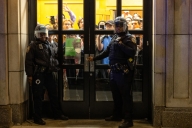You have /5 articles left.
Sign up for a free account or log in.

William_Potter/Getty Images
Broad-access institutions, often community colleges and regional public universities, defined as those that admit 80 to 100 percent of applicants, spend a little less than $15,000 on academic basics for each full-time-equivalent student.
Highly selective institutions, defined as those that admit less than 40 percent of applicants, spend just over $52,000 per student.
This stark difference illustrates a need for better funding mechanisms for colleges, according to Nick Hillman, an associate professor at the School of Education at the University of Wisconsin at Madison and author of a new Third Way report that analyzed these data. The report includes colleges and universities that receive Title IV federal funding, except for for-profit and specialized institutions.
In his report, Hillman argues the allocation of state and federal funds to different types of institutions is inequitable, thus driving further inequities for students. He used data from the Integrated Postsecondary Education Data System on education and related expenditures to capture the most basic necessary costs for institutions to properly serve students. The education and related expenditures numbers include the cost of instruction, as well as student support services and their associated administrative costs, but not items like athletics, research or housing.
John Cheslock, an associate professor at Pennsylvania State University, said this is a reasonable measure of spending used to promote student success.
"Some may read it and say, 'Big deal. Some colleges have different missions than others,'" Hillman said. "I would disagree with that. We’re measuring the cost of core instructional activity and administrative costs to support students."
Homing in on these data reveal structural inequities in how well different types of institutions are able to serve their students at the most basic level, he said.
"In higher education finance, we don’t talk about equity-based funding or adequacy-based funding, yet these are very well-trod areas in K-12 education finance," Hillman said. "We need to talk about it more in higher education."
The data show that the more selective an institution is, the more it spends on these basic academic costs per full-time-equivalent student. It also shows that the more selective an institution is, the fewer people it serves.
This is true for the most vulnerable students, as well. More selective institutions serve fewer low-income students and students of color compared to broad-access colleges.
While enrollment of Pell Grant recipients and Black students has been declining since about 2010 at broad-access institutions but holding steady at more selective institutions, the report states that is not because selective colleges are increasing the number of spots for these students. Instead, it's because fewer students are enrolling in broad-access colleges over all.
Since broad-access institutions still enroll the greatest numbers of students of color and low-income students, the spending gaps are especially harmful for racial and socioeconomic equity, according to the report. Most of these students are attending the lowest-funded institutions in the country. For example, only 10 percent of Pell Grant recipients attend the best-funded colleges. So low-income students are likely getting professors with low salaries and fewer supports, even though these students likely need more supports and opportunities than others.
This isn't surprising to some higher education experts.
"[The report] shows quantitatively what we’ve known qualitatively for a long time," said Wil Del Pilar, vice president of higher education policy and practice at the Education Trust. "We treat the institutions that enroll low-income students and students of color the same way we treat those students. We expect them to do more with less, to be more resilient, to make it work."
It's a vicious cycle in which the better-resourced colleges are able to continue getting more resources, while lower-resourced colleges languish. Public flagship universities, for example, tend to have more resources to lobby state legislatures so they can get more resources, Hillman said. More selective institutions may have high-profile alumni who can do lobbying work.
Some studies have shown that colleges that are less diverse do better in the budget cycle, depending on what political party controls the state.
"Those very institutions that don't have resources are where most people of color are enrolled," Hillman said, adding, "States need to be willing to look at some facts and look at the allocation of resources layered on top of who enrolls where. It could soften some people's hearts and minds up."
It's an issue experts need to think more about, said Del Pilar.
"The way we fund institutions in K-12 and higher education is to reproduce inequities," he said.
Hillman's report recommends that states run a higher education funding equity audit. It also calls on federal policy makers to create grant programs, similar to Title I of the Elementary and Secondary Education Act, to give funds directly to broad-access colleges serving large numbers of low-income students and students of color. These colleges could also receive a federal designation, similar to the designation of minority-serving institution, that would trigger additional federal aid or other resources.
It's important to encourage states to incentivize enrolling and graduating more students of color, Del Pilar said. Federal leaders could also provide Pell Grant "bonuses" to colleges that enroll a certain number of Pell Grant recipients, to be used for wraparound supports and services for those students, he said.
"There’s an economic and a moral argument to be made for why this is important," Del Pilar said. It's morally correct to help more vulnerable students, but it's a wise economic choice to ensure states continue to have strong workforces and tax bases, he said.
More money over all is needed for these changes, though, said Victoria Jackson, a senior policy analyst at the Center on Budget and Policy Priorities. In a 2019 report on higher education funding, the center found that states were spending $6.6 billion less on public higher education institutions than they were before the Great Recession of 2008, adjusting for inflation.
Ensuring the funding is equitable isn't enough, she said. There has be more funding to draw from. Jackson advocates for raising taxes in a progressive way on top earners.
"If we don’t have enough money in the system, even if we make allocations equitable, it’s not going to do enough," she said. "We need to see significant increases in funding, and to do that, states need to raise taxes."
The largest roadblocks to these changes are political will and economic uncertainty, Hillman said. Higher education thought leaders need to bring new ideas to the table to stoke movement on these issues, he said.
"It’s going to be a long haul, but I see a path forward," he said. "This is a conversation that’s long overdue, and one we haven’t had in earnest as a country, and it sure would be the time to do it."








